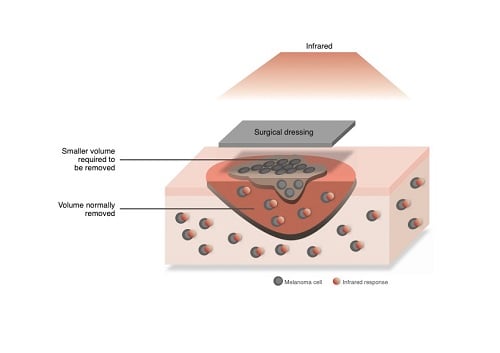S. Himmelstein | July 27, 2022
A surgical dressing synthesized by an international research team enhances photothermal therapy following melanoma resection, destroys remaining cancer cells and simultaneously regenerates healthy cells within the resection site.
The dressing combines graphene oxide as a photothermal agent, elastin and ethanol. The latter serves to chemically reduce the graphene oxide, making photothermal therapy more efficient and forming an antiseptic component within the dressing. The dressings described in Advanced Functional Materials only require 15 seconds of irradiation with near-infrared light every 48 hours to produce effective photothermal The photothermal therapy efficiency of surgical dressing would enable much smaller surgical resections compared to current procedures and eliminate residual melanoma cells. Source: University of Nottingham therapy. Patients could even administer the light therapy by themselves at home.
The photothermal therapy efficiency of surgical dressing would enable much smaller surgical resections compared to current procedures and eliminate residual melanoma cells. Source: University of Nottingham therapy. Patients could even administer the light therapy by themselves at home.
The photothermal therapy efficiency of the surgical dressings would enable much smaller surgical resections compared to normal procedures requiring large resections. The near-infrared radiation treatment would also enable elimination of residual melanoma cells.
“These materials could be used as dressings for post-surgery treatment and healing of skin cancer, operating within a narrow temperature window where “bad” cells are killed and “good” cells are not,” explained the researchers.
Scientists from University of Nottingham (U.K.), Shanghai Jiao Tong University (China), University of Trento (Italy), University of Strathclyde (U.K.), Imperial College London, University of Valladolid (Spain), Queen Mary University of London and Huazhong University of Science and Technology (China) contributed to this development.
